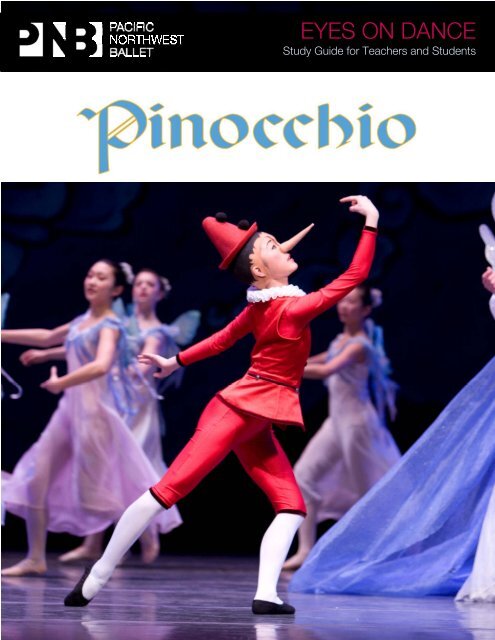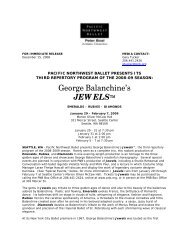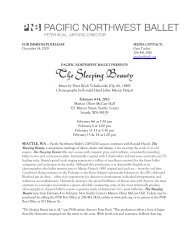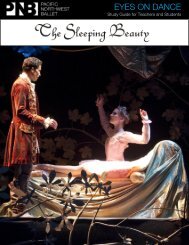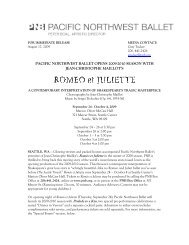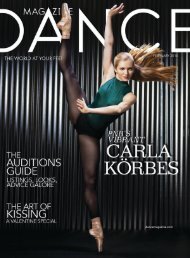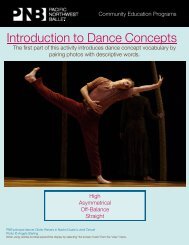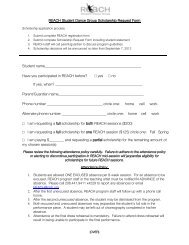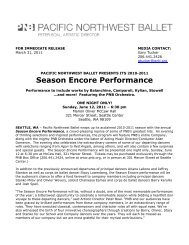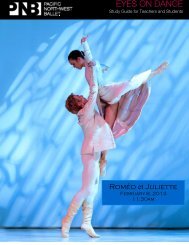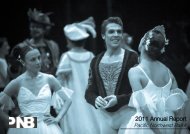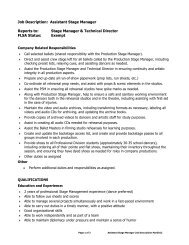Create successful ePaper yourself
Turn your PDF publications into a flip-book with our unique Google optimized e-Paper software.
EYES ON DANCE<br />
Study Guide for Teachers and Students
Table of Contents<br />
Page 3 ………………………………….About <strong>Pacific</strong> <strong>Northwest</strong> <strong>Ballet</strong><br />
Page 4 …………………………………The Story of <strong>Pinocchio</strong><br />
Pages 5-6 ………………………………….About <strong>Pinocchio</strong><br />
Page 7 ………………………………….Discussing Dance & Movement Activities<br />
Page 8 ………………………………….Attending a <strong>Ballet</strong> Performance<br />
Page 9 ..………………………………..Additional Resources<br />
The March 25, 2011 EYES ON DANCE matinee of <strong>Pinocchio</strong> will feature the entire one-hour,<br />
narrated ballet, performed by nearly sixty students from <strong>Pacific</strong> <strong>Northwest</strong> <strong>Ballet</strong> School<br />
(PNBS). The performance will begin at 10:30am and will not have an intermission.<br />
This study guide was created by <strong>Pacific</strong> <strong>Northwest</strong> <strong>Ballet</strong>’s Community Education Programs staff for<br />
use by teachers and students attending the EYES ON DANCE matinee of <strong>Pinocchio</strong>. Reproduction of<br />
this guide in its entirety is allowed and encouraged, when proper credits are included.<br />
For questions, call 206.441.2432.<br />
PNB thanks the following for their support of PNB Community Education Programs:<br />
Bellevue Arts Commission, William Randolph Hearst Foundation, Horizons Foundation, JPMorgan Chase Foundation,<br />
Kobe Foundation, Lockwood Foundation, D.V. and Ida J. McEachern Charitable Trust, National Endowment for the Arts,<br />
PONCHO, Safeco Insurance Foundation, Tulalip Tribes Charitable Fund, Washington State Arts Commission,<br />
Peg and Rick Young Foundation, and generous individual contributors.<br />
Cover photo:<br />
<strong>Pacific</strong> <strong>Northwest</strong> <strong>Ballet</strong> School Students in Pinnochio<br />
All Photos © Angela Sterling, unless otherwise noted<br />
Page | 2
About <strong>Pacific</strong> <strong>Northwest</strong> <strong>Ballet</strong><br />
Foundedd in 1972, <strong>Pacific</strong> <strong>Northwest</strong> <strong>Ballet</strong><br />
(PNB) is one of<br />
the largest and most highly regarded ballet companies in<br />
the United States. In<br />
July 2005, Peter Boal became artistic<br />
director, succeeding<br />
Kent Stowell and Francia Russell,<br />
artistic directors since 1977. The Company of forty-six<br />
dancers presents approximately 100 performances each<br />
year of full-length and mixed repertory ballets at Marion<br />
Oliver McCaw Hall and on tour. The Company is made up<br />
of dancers from across the world—including France,<br />
Japan, Brazil, Cuba, Mongolia, and the United States.<br />
The Company has toured to Europe, Australia, Taiwan,<br />
Hong Kong, Canada, and throughout the<br />
United States,<br />
with celebrated appearances at Jacob’s Pillow and in New<br />
York City and Washington, DC. Under the<br />
direction of Peter<br />
Boal, PNB has continued to expand and diversify its<br />
repertory to include<br />
works by Ulysses Dove, Susan<br />
Marshall, Mark Morris, Victor Quijada, Twyla Tharp,<br />
Christopher Wheeldon, and others.<br />
Foundedd in 1974, <strong>Pacific</strong> <strong>Northwest</strong> <strong>Ballet</strong><br />
School, under<br />
the direction of Francia Russell since 19777 and now under<br />
Mr. Boal's direction, is nationally recognized as setting the<br />
standardd for ballet training and offers a complete<br />
professional curriculum to more<br />
than 950 students. PNB’s<br />
Community Education Programs provide comprehensive<br />
dance education to the greaterr Seattle area and reach more<br />
than 12,000 adults and children each year<br />
through EYES ON<br />
DANCE, DISCOVER DANCE, and other community programs<br />
and activities.<br />
Photos, top<br />
to bottom:<br />
PNB Soloist<br />
Chalnessa Eames and PNB Company dancers in<br />
The Sleeping Beauty<br />
PNB Principal Dancer Jeffrey<br />
Stanton and PNB Company dancers in George Balanchine’s<br />
Symphony in Three Movements, © The George Balanchine Trust<br />
PNB School students in pas de deux class with PNB dancer/ PNBS faculty member Stanko Milov<br />
PNB DISCOVER DANCE teaching artist Suzanne SIngla with 3 rd grader at Graham Hill Elementary<br />
(DISCOVER DANCE photo © Bill Mohn)<br />
Page | 3
The Story of <strong>Pinocchio</strong><br />
<strong>Pinocchio</strong> begins with a group of puppets rehearsing for the<br />
evening’s puppetry performance. Small puppets appear and<br />
ask the puppeteer to read aloud the story of <strong>Pinocchio</strong>. No<br />
longer a puppet, a grown up <strong>Pinocchio</strong> enters and joins the<br />
group. Blindfolding <strong>Pinocchio</strong>, the small puppets bring a full<br />
length mirror into the scene and when the blindfold is<br />
removed, <strong>Pinocchio</strong> sees himself reflected in the mirror as<br />
the puppet he used to be. The puppet in the reflection<br />
steps out of the mirror, bows to <strong>Pinocchio</strong>, and is followed<br />
by characters grown up <strong>Pinocchio</strong> remembers from when he<br />
was a puppet - his father Geppetto, his friend The Talking<br />
Cricket, the beggars Fox & Cat, and his beloved Blue Fairy.<br />
The scene changes to Geppetto’s workshop in a flash-back<br />
where he is creating the puppet <strong>Pinocchio</strong>. Geppetto gives<br />
<strong>Pinocchio</strong> a spelling book and sends him to school, but<br />
along the way he becomes preoccupied watching<br />
performers from the Puppet Theater. He quickly sells the<br />
spelling book to buy a ticket to the performance. Greeted by<br />
others like himself, <strong>Pinocchio</strong> dances with the puppets and<br />
is paid 5 gold coins for his performance.<br />
Photos (top-bottom):<br />
PNBS students in an opening scene from <strong>Pinocchio</strong><br />
PNBS student as The Talking Cricket<br />
Alexandra Dickson and a PNBS student as The Blue Fairy and <strong>Pinocchio</strong><br />
Soon <strong>Pinocchio</strong> is set upon by Fox & Cat, who swindle him<br />
out of his earnings by telling him to bury his gold in the Field<br />
of Miracles. “By doing so, it will grow on a tree and you will<br />
find countless gold coins in the morning,” they say. But<br />
while <strong>Pinocchio</strong> is asleep, Fox and Cat steal his money and<br />
shortly after he discovers his loss, Blue Fairy appears to<br />
offer consolation. Embarrassed by his actions, <strong>Pinocchio</strong><br />
begins to lie about where the money is, and with each lie,<br />
his nose grows. Blue Fairy tells <strong>Pinocchio</strong> she will only<br />
forgive him if he goes to find his father Geppetto, who has<br />
been traveling across the ocean searching for him.<br />
<strong>Pinocchio</strong> goes to the sea side and dives into the deep.<br />
Here he meets Neptune, King of the Sea, and his court.<br />
Before long, he discovers Geppetto has been swallowed by<br />
a whale. Mustering all the strength he can manage,<br />
<strong>Pinocchio</strong> pulls his father from the whale’s belly. Witnessing<br />
a truly unselfish act by the puppet, Blue Fairy appears and<br />
turns the puppet into a real boy. With a humble sigh,<br />
<strong>Pinocchio</strong> announces:<br />
“How foolish I was when I was a puppet … and how happy I<br />
am to have become a real boy”<br />
Page | 4
About <strong>Pinocchio</strong><br />
History & Creation<br />
Originally written as a series of adventures by Carlo Collodi, <strong>Pinocchio</strong> is<br />
one of the world’s most well recognized characters. Written in 1883 by<br />
Collodi, The Adventures of <strong>Pinocchio</strong> was the first novel featuring the<br />
character. Named for the Tuscan word meaning “pine nut”, <strong>Pinocchio</strong> is<br />
a puppet carved out of pine wood by a woodcarver named Geppetto.<br />
<strong>Pinocchio</strong>’s curious nature and dreams of becoming a real boy are the<br />
source for these now-famous stories. In 1940, Disney adapted the story<br />
into an animated musical children’s movie, their second animated film<br />
after Snow White and the Seven Dwarfs. This version marked the first of<br />
many theater, film, dance, and other artistic variations of the story.<br />
<strong>Pacific</strong> <strong>Northwest</strong> <strong>Ballet</strong>’s <strong>Pinocchio</strong> was conceived and<br />
choreographed by <strong>Pacific</strong> <strong>Northwest</strong> <strong>Ballet</strong> School Faculty Member Bruce Wells in 2009. He<br />
was inspired to create <strong>Pinocchio</strong> in order to offer an additional performing opportunity for the<br />
PNBS students. The ballet is performed by the most advanced students of PNBS—levels VI<br />
through the Professional Division (ages 13-20). Professional Division students at PNB are fulltime<br />
pre-professional level dancers. They spend one or two years at PNB studying ballet,<br />
partnering, modern dance, and PNB repertory and often perform with the Company. In<br />
addition to the 60 students, Mr. Wells serves as the narrator, or Puppeteer, in the ballet and<br />
former PNB Soloist Alexandra Dickson dances the role of The Blue Fairy.<br />
Photos (top-bottom):<br />
Original artwork by Enrico Mazzanti for the first publishing of The Adventures of <strong>Pinocchio</strong> (1883)<br />
Bruce Wells in rehearsal<br />
Choreography and Concept: Bruce Wells<br />
Choreographer Bruce Wells has created over 50 ballets. A native of<br />
Tacoma, Washington, Mr. Wells' dance career began as a student at the<br />
School of American <strong>Ballet</strong>. He joined New York City <strong>Ballet</strong>, under the<br />
direction of George Balanchine, in 1967 and was promoted to soloist in<br />
1969. His choreographic career began in workshops that Mr. Balanchine<br />
coached in the early 1970's. From there he became resident<br />
choreographer for the Connecticut <strong>Ballet</strong> from 1975 to 1979,<br />
choreographing his first full length ballet, Coppelia in 1976. From 1979 to<br />
1989 Mr. Wells was resident chorographer for the Boston <strong>Ballet</strong>, where<br />
he created over 20 works which included The Nutcracker, La Fee Mal<br />
Gardee, Swan Lake, and his highly acclaimed A Midsummer Night's<br />
Dream (from 1984 to 1989 he was also Associate Artistic Director for the<br />
company). He then joined Pittsburgh <strong>Ballet</strong> Theater for six seasons as resident choreographer,<br />
creating new productions of Romeo & Juliet, Firebird, and The Great Gatsby, among others. Mr.<br />
Wells has choreographed works for The Australian <strong>Ballet</strong>, Dance Theater of Harlem, <strong>Pacific</strong><br />
<strong>Northwest</strong> <strong>Ballet</strong>, Atlanta <strong>Ballet</strong>, Milwaukee <strong>Ballet</strong>, <strong>Ballet</strong> Chicago, Cincinnati <strong>Ballet</strong>, The<br />
Nashville <strong>Ballet</strong>, Oregon <strong>Ballet</strong> Theater, Jacob's Pillow, and many more. For the past eleven<br />
years, Mr. Wells has been on the faculty of <strong>Pacific</strong> <strong>Northwest</strong> <strong>Ballet</strong> School. Mr. Wells' first<br />
children’s ballet for PNBS was Snow White in 2001, followed by Hansel & Gretel in 2006 and<br />
<strong>Pinocchio</strong> in 2009. A frequent guest teacher and free lance choreographer, his most recent<br />
assignment was as guest teacher for the Dutch National <strong>Ballet</strong> in Amsterdam.<br />
Page | 5
Costumes:<br />
<strong>Pacific</strong>c <strong>Northwest</strong> <strong>Ballet</strong> Costume Shop<br />
For Pinnochio, choreographer Bruce<br />
Wells collaborated<br />
with Costume<br />
Shop Manager Larae Hascall and the<br />
entire shop staff for<br />
each costume. Sketches for principal<br />
roles (<strong>Pinocchio</strong>, The Blue Fairy, etc.) weree drawn by Mr. Wells<br />
and then<br />
created by<br />
shop employees. For the other roles,<br />
existing costumes from the PNB repertory<br />
were used. By<br />
carefully selecting, editing, and<br />
altering these pieces to match<br />
the new ones, a cohesive look was established.<br />
Scenery: edie whitsett<br />
PNB’s<br />
Costume Shop is a permanent, fully-staffed, in-house<br />
production center<br />
located at PNB’s Phelps Center. Established with<br />
the company in 1972, the shop’s earlierr years focused on<br />
maintenance and construction of smaller ballets. By 1989, with the<br />
premiere of Firebird, the shop had grown to the point where staff had<br />
the ability to produce all of the costumes needed for a major work.<br />
Since 1987 nearly<br />
every costume worn by PNB dancers has been<br />
built in<br />
PNB’s costume shop.<br />
edie is<br />
delighted to be working again with Bruce Wells<br />
and PNB. Their previous collaborations<br />
include Snow<br />
White and Hansel and Gretel. Her PNB<br />
credits include<br />
<strong>Ballet</strong> Imperial, Chrysalis Regarding and<br />
Zirkus Weill. Her<br />
other credits are Lucia Di Lammermoorr for Seattle Opera,<br />
Arms and the Man for Intiman, Souvenir<br />
for ACT, The<br />
Pied Piper for Tacoma Opera and numerous designs for<br />
Seattlee Children's<br />
Theatre— including The Brementown<br />
Musicians, High School Musical, Charlotte's Web, The<br />
Velveteen Rabbit,<br />
and even <strong>Pinocchio</strong>. edie lives in<br />
Seattlee and is a set designer<br />
with Seattle Children’ s<br />
Theater.<br />
Page | 6<br />
Photos (top-bottom):<br />
Mask<br />
worn by <strong>Pinocchio</strong> (Photo by Larae Hascall)<br />
Close<br />
up of the wings from the Cricket costume (Photo by Larae Hascall)<br />
PNBS<br />
student as Geppetto in front of the scenery from <strong>Pinocchio</strong><br />
Entire<br />
cast of <strong>Pinocchio</strong>
Discussing Dance & Movement Activities<br />
Pre-performance Discussion:<br />
Describe ballet to students as a way to communicate stories, ideas, and feelings without<br />
using words. Dancers have to move and act in ways that let the audience know what<br />
their character is experiencing. Ask them how they can tell if someone is angry, happy,<br />
sad, or frightened just by walking into a room.<br />
Pre-performance Questions:<br />
What kinds of movements and facial expressions correspond to happiness Anger<br />
Would these movements be fast or slow Sharp or smooth Can you show some ideas<br />
What steps would you do, or expect to see, when a character is celebrating<br />
Do you expect the steps and movements in the ballet to be classical or contemporary<br />
Pre-performance Movement Activity:<br />
1. Students generate two lists of words. The first will be a list of movement/action words. Challenge<br />
students to expand their list by asking questions such as, “What are different ways of walking<br />
Let’s try some ways of moving around the room.” You can also show photos or videos of<br />
dancers or statues, and have them describe what they see.<br />
2. The second list will be of descriptive words. Depending on grade level, this might be a list you<br />
produce on your own rather than brainstorm with students.<br />
Sample lists are below. We provided dance concepts as descriptive words.<br />
List 1: MOVEMENT WORDS<br />
List 2: DESCRIPTIVE WORDS<br />
Run Walk TipToe SIZE (big, medium, small)<br />
Gallop Skip Swing LEVEL (high, middle, low)<br />
Jump Leap Twist DIRECTION (forward, backward, sideways)<br />
Kick Spin Sway PATHWAY (curved, straight, zig zag)<br />
Rise Stretch March SPEED (fast, medium, slow)<br />
Reach Float Balance WEIGHT (heavy, light)<br />
Bend Prance Shake ENERGY (sharp, smooth, shaky, swingy)<br />
3. Once you have created a list, ask students to create their own <strong>Pinocchio</strong> choreography.<br />
Choreography is the process of putting steps together to create a dance. Ask questions like “what<br />
steps/descriptive words could show <strong>Pinocchio</strong> when he is scared” This might be running<br />
backwards or tip toeing with shaky energy. Gather a few answers and have students try them out.<br />
4. Put two or three movements together to create a short phrase of choreography.<br />
5. Create a total of three choreographic phrases- one each for the beginning, middle, and end!<br />
Post-performance Questions:<br />
Did the choreography fit the emotion of each scene<br />
What elements of the performance helped you the most in understanding the story<br />
Were there any parts of the choreography were confusing to you Why<br />
How did the choreography compare to the movements we created<br />
Page | 7
Attending a <strong>Ballet</strong> Performance<br />
Going to the theater for ballet is similar to going to a movie:<br />
• The lights will dim before the performance begins, and<br />
it will be dark in the theater during the ballet.<br />
• Audience members are expected to sit still and<br />
quietly in their seats.<br />
• Photography and video recording are strictly prohibited.<br />
In addition to being distracting to the dancers and other<br />
audience members, <strong>Pinocchio</strong> is copyrighted.<br />
• Cell phones and electronics should be turned off when<br />
you enter the theater.<br />
• There is no intermission. Use the restroom prior to the<br />
performance.<br />
However, unlike the movies:<br />
• <strong>Ballet</strong> is performed live. There are no second<br />
takes and dancers can react to the audience!<br />
• While there is a narrator for <strong>Pinocchio</strong>, dancers do<br />
not talk in ballet. They tell the story through<br />
movements, music, costumes, and sets.<br />
• Clap when you enjoy something, laugh if<br />
something is funny, and give a standing ovation at<br />
the end if it was amazing. Let the performers<br />
know you appreciate their hard work!<br />
• McCaw Hall is a big theater—nearly 3,000 seats!<br />
• At the end of the performance, the dancers and<br />
narrator take a bow. This is a curtain call.<br />
• Some people make their visit to the ballet a dressup<br />
occasion; others dress casually. Wear<br />
something you are comfortable in so you can<br />
enjoy the performance.<br />
Most Importantly:<br />
• Enjoy the movements, music, sets, costumes—and HAVE FUN!<br />
Page | 8<br />
Photos (top to bottom)<br />
Second grade students arrive at Marion Oliver McCaw Hall (photo by Bill Mohn)<br />
Elementary students at McCaw Hall (Photo by John Austin) Marion Oliver<br />
Marion Oliver McCaw Hall, exterior (photo by Roger Burnett)
Additional Resources<br />
LITERATURE:<br />
For young students (ages 4-8):<br />
The Story of <strong>Pinocchio</strong><br />
Carlo Collodi Illustrations by Mauro Evangelista Usborne Books, 2006<br />
ISBN: 978-0794511487 Available at www.amazon.com<br />
For older students (ages 9-12):<br />
<strong>Pinocchio</strong> (Penguin Classics)<br />
Carlo Collodi Penguin Classics, 2002<br />
ISBN: 978-0142437063 Available at www.amazon.com<br />
For teens:<br />
The Adventures of <strong>Pinocchio</strong><br />
Carlo Collodi (translated by Nancy Canepa) Zoland Books, 1998<br />
ISBN: 978-1586420529 Available at: www.amazon.com<br />
VIDEO / WEBSITE:<br />
Webcasts and photos about the making of <strong>Pinocchio</strong> can be found at PNB’s website:<br />
http://www.pnb.org/Season/10-11/<strong>Pinocchio</strong>/#Media<br />
Support PNB! Link to Amazon.com through PNB’s website and PNB will receive up to 10% of the<br />
purchase price. More information at http://www.pnb.org/Support/Amazon.aspx<br />
Additional Activities:<br />
Visit PNB’s website at http://www.pnb.org/Community/Teacher/ for:<br />
o Movement activities and lessons<br />
o Dance vocabulary activities<br />
o A behind-the-scenes study guide<br />
o Information on scheduling in-school workshops<br />
o Professional development workshops for teachers<br />
o PNB Teacher Discount for performance tickets<br />
For information or questions, please call PNB’s Community Education Programs at 206.441.2432<br />
PNB Company dancers during curtain call of Ronald Hynd’s The Sleeping Beauty.<br />
Page | 9


